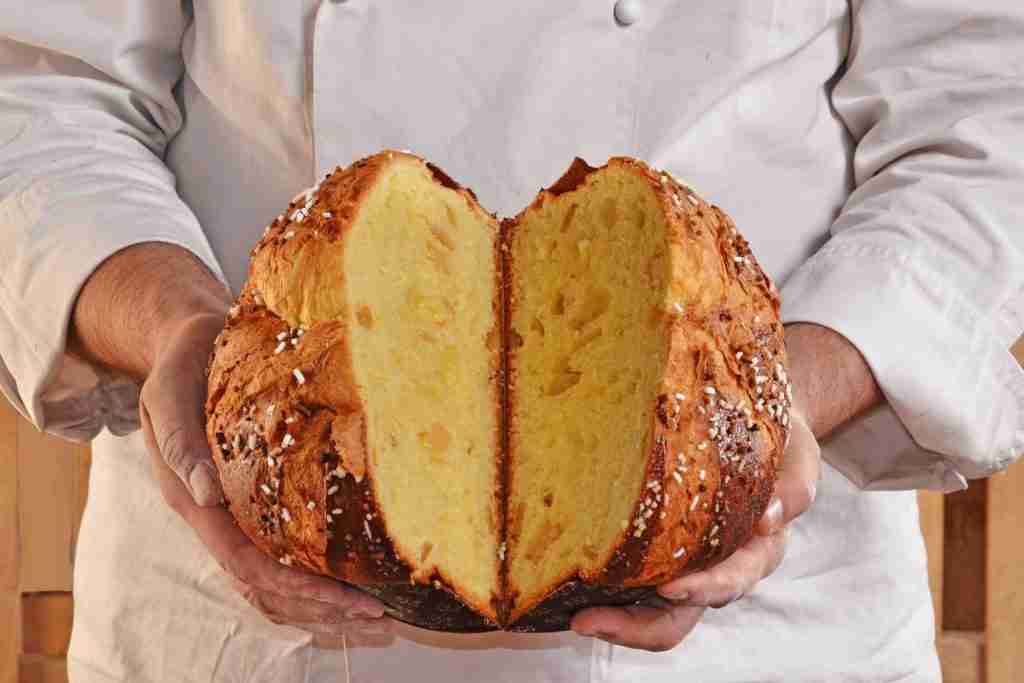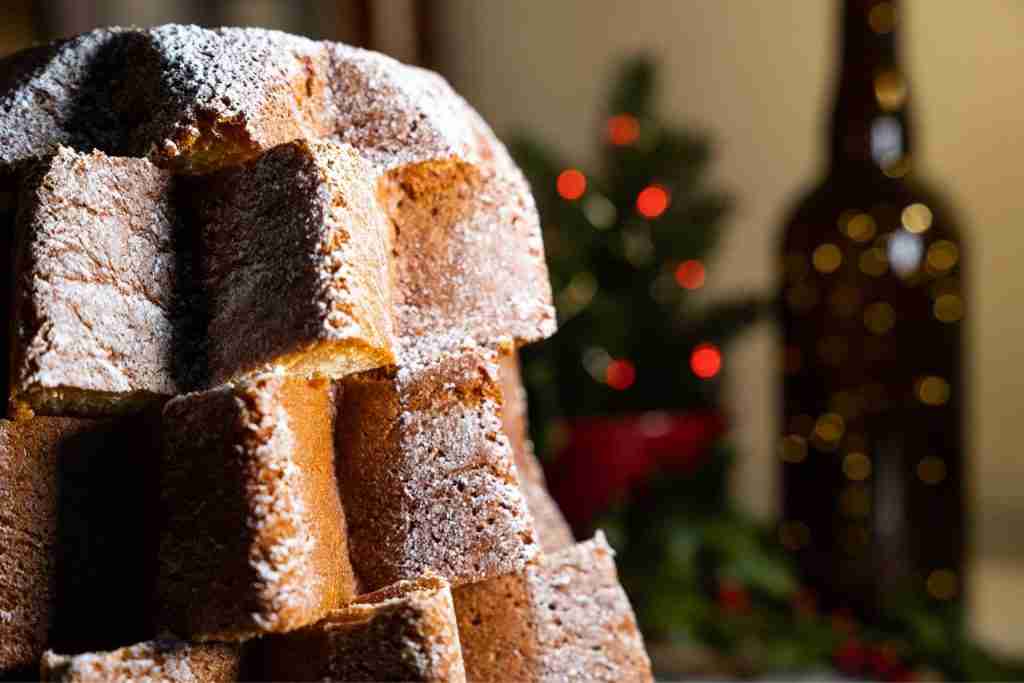Which ones are traditional Italian Christmas cakes? In Italy the whole month of December is particularly heartfelt, full of celebrations and festivities: from Christmas to La Befana, the entire month is celebrated with unique culinary traditions. Among the most famous and appreciated Christmas desserts there are certainly panettone and pandoro, two leavened products that adorn Italian tables during the holidays.
As we will see later, Panettone has ancient origins dating back to the 15th century in Milan, and is made from flour, raisins, candied orange peel and natural yeast. It has a tall, soft dome shape and is considered the king of Christmas desserts. Pandoro, on the other hand, was born in the first half of the 19th century in Verona and has an eight-pointed star shape. It is prepared with flour, sugar, eggs and butter without candied fruit.
These sweets are much more than simple desserts: they represent true icons of Christmas, culinary symbols that unite Italians during the holidays. In this content we’ll talk about traditional Italian Christmas cakes: history and differences between Panettone and Pandoro.
“A piece of panettone and a cup of coffee: the perfect combination to celebrate Christmas.”
Sophia Loren

Traditional Italian Christmas cakes: a family tradition
Each family has its own traditions on which one to prefer, panettone or pandoro, and there is never a shortage on the laid tables. They represent a moment of sharing and happiness to be enjoyed in the company of loved ones.
But do you know where these two confectionary giants we love so much come from? And what makes them different from each other?
Get ready, because we’re about to take a journey through history, traditions and flavors to find out everything you need to know about panettone and pandoro. We assure you that by the end you will be a true expert, ready to make the right choice when you stand in front of the dessert shelf or when you’ll receive this wonderful dessert directly to your home via our LCN App.
Traditional Italian Christmas cakes: the origins of panettone – a slice from Milan
Panettone is closely associated with the city of Milan and the region of Lombardy. Its roots go back to the Middle Ages, but it was in the 20th century that it gained national and international fame.
One of the best-known legends tells of a cook in the service of Ludovico il Moro, who during a Christmas banquet burns the cake planned for the guests. A young apprentice, Toni, suggests using a spare dough he had prepared for himself, made with raisins, candied fruit, and sugar. The cake is an extraordinary success, and from then on it is called “Pan de Toni,” evolving over time into the panettone we know today.
Traditional Italian Christmas cakes: the origins of pandoro – Verona’s gold
Pandoro, in contrast, originated in Verona and is a more recent tradition than panettone. Its history begins in the late 19th century, when it was patented by Domenico Melegatti, a pastry chef from Verona. The name “pandoro” is a cross between “pane” (bread) and “d’oro” (made of gold), to represent the cake’s star shape and golden surface. Pandoro was inspired by Nadalin a traditional Christmas cake from Verona, but has become famous throughout the country and abroad for its softness and its surface covered with powdered sugar.

Traditional Italian Christmas cakes: basic differences between panottone and pandoro
Panettone and pandoro are two very different cakes both in shape and ingredients. Panettone is a dome-shaped leavened cake with a soft texture and a recipe that includes candied fruit and raisins. Pandoro is also a leavened cake, but it has a star shape, is fluffier, and is served dusted with powdered sugar to imitate, according to tradition, snow on the mountains.
Traditional Italian Christmas cakes: cultural importance and regional variations
Both desserts have earned a place of honor in Italian Christmas traditions, but while panettone has become a symbol of Milanese and Lombard food craftsmanship, pandoro represents Veneto and innovation in the world of pastry making.
Regional variations, are also reflected in recipes: today there are versions of panettone with ingredients typical of other Italian regions, such as Sicilian pistachio or limoncello cream. Similarly, pandoro lends itself to being filled with creams of various flavors, from alchermes to Nutella.
The Italian ritual of cutting and eating in the family
To enjoy these delicacies at their best, there are very specific rituals. Panettone, for example, should be cut into vertical slices so that each diner receives a portion that includes all parts of the cake. Pandoro should be cut following the star-shaped segments, and each slice is then sprinkled with powdered sugar. So, you have to insert the knife’s tip gently then glide it downwards while ensuring your hand remains along the pandoro’s side rather than atop it.
The initial incision splits the cake into two halves. Next, make a perpendicular cut, forming a cross shape, and continue diagonally from there until you’ve sliced the desired portions. Both pandoro and panettone are traditionally accompanied by sparkling wine or sweet wines, such as Moscato or Passito.

Traditional Italian Christmas cakes: an all-Italian process of art and patience
Both of these cakes require a rather laborious production process that emphasizes the craftsmanship and tradition behind them. Panettone, for example, requires a leavening process that can last more than 12 hours and the use of sourdough starter. This laborious process is part of the reason it is considered a high-quality product.
Pandoro, although it does not include candied fruit or raisins, has a layered structure that requires several stages of rising and kneading, also making it a laborious product to make. The preparation of both cakes is a real ritual that begins months before Christmas in bakeries and in the homes of those who choose to make their own.

The pairings: beyond the Christmas slice
If you think that panettone and pandoro are only to be enjoyed “au naturel,” you are sadly mistaken. In recent years, many chefs and food bloggers have begun to experiment with these desserts, using them as a base for other preparations.
For example, panettone can be used to make delicious variations of the classic tiramisu or as an ingredient for an unusual version of pudding. Pandoro, lends itself well to being filled with gelato or creams and is also used to create spoon desserts. These variations not only expand the possibilities of enjoying these desserts, but also represent a form of evolution of Italian culinary traditions.
Traditional Italian Christmas cakes: panettone and pandoro in the world
Given the immense popularity of these cakes in Italy, it is not surprising that they have begun to conquer international palates as well. Today, it is possible to find panettone and pandoro in many parts of the world, especially in countries with a strong presence of Italian communities.
Interestingly, outside of Italy, the two desserts are often seen as variations of the same Christmas theme and are both popular, although they are consumed in ways that may diverge from Italian traditions. For example, in some cultures panettone is eaten toasted with butter, while in others it is enjoyed with coffee or tea.

The Bottom Line
In this content we learned about traditional Italian Christmas cakes: history and differences between Panettone and Pandoro. Panettone and pandoro represent not only two different regional traditions but also two different ways of experiencing and celebrating Christmas. Whether you are a lover of panettone, with its richness of candied fruit and raisins, or a fan of pandoro, with its sweet simplicity, one thing is certain: both of these sweets carry with them the magic and history of the Italian holidays.
Panettone and Pandoro are ambassadors of Italian pastry around the world. Now famous and appreciated globally, they are perfect for bringing a little of the spirit and flavors of Italian Christmas everywhere. Their success lies in the goodness of the raw materials, careful craftsmanship and the evocative power of these sweets that can recreate the magic of Christmas.
And now that you know their origins and differences, you will be able to make a more informed choice when it comes to decorating your Christmas table. Whether you opt for an artisanal panettone or a stuffed pandoro, the most important thing is to enjoy the moment in the company of your loved ones.

